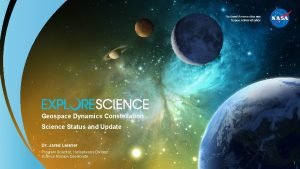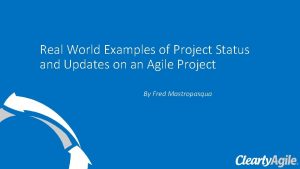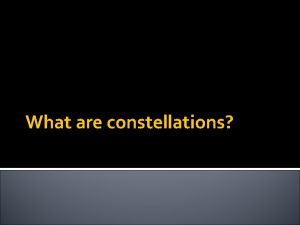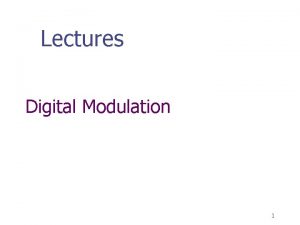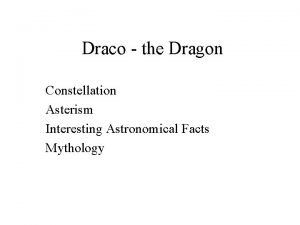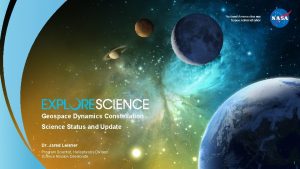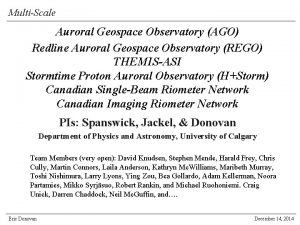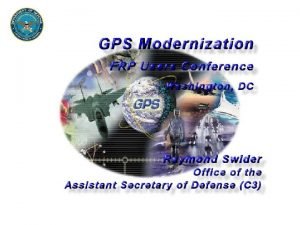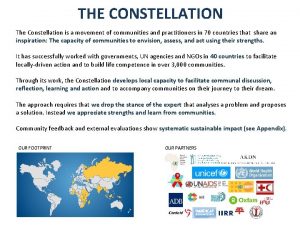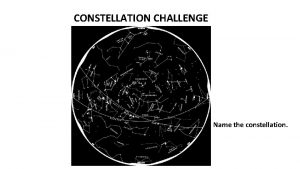Geospace Dynamics Constellation Science Status and Update Dr








- Slides: 8

Geospace Dynamics Constellation Science Status and Update Dr. Jared Leisner Program Scientist, Heliophysics Division Science Mission Directorate 1

Background • Geospace Dynamics Constellation (GDC) was the next LWS mission recommended by the 2013 Decadal Survey. • In late 2017, Heliophysics Division (HPD) started GDC pre-formulation work. • RFI solicited information from the community • Science and Technology Definition Team (STDT) convened • In late 2019, the GDC STDT delivered their final report to the Heliophysics Advisory Committee (HPAC). • HPAC endorsed the report’s science • HPAC recommended NASA continue preformulation with an implementation study • https: //science. nasa. gov/heliophysics/resources/stdts/g eospace-dynamics-constellation 2

GDC Science • The STDT updated the 2013 Decadal Survey’s GDC recommendations. It focused the scope of the science to a set of science objectives that would be achieved within the GDC investigation. • The STDT report outlines an exciting science investigation to fundamentally advance understanding of the ionosphere-thermosphere (IT) system. • Goal 1: Understand how the high latitude ionosphere-thermosphere system responds to variable solar wind/magnetosphere forcing. • Goal 2: Understand how internal processes in the global ionospherethermosphere system redistribute mass, momentum, and energy. 3

GDC Science • Three groups of focused, achievable science objectives identified: • Core: The central focus for understanding the coupled IT system. • Obj. 1. 1: Determine how high-latitude plasma convection and auroral precipitation drive thermospheric neutral winds. • Core Comprehensive: How the neutral winds drive structures and changes within the coupled IT. • Core Enhancing: The intrinsic variability in the background state of the IT and how it regulates the flow of energy through it. • Compelling science to be met at global, regional, and local scales for these objectives • Synergy with ground-based observations, enabling and enhancing model development and laboratory work • Science objectives require a spacecraft constellation that can evolve through time 4

GDC STDT Report • Report delivered to HPAC in Oct. 2019 by STDT co-chairs Aaron Ridley (Univ. of Michigan) and Allison Jaynes (Univ. of Iowa) • HPAC endorsed the STDT’s work, the GDC science, and the report. • “HPAC finds that the STDT’s work was exemplary and laudable, and extends its sincere appreciation for the very significant amount of work the STDT members have volunteered towards the deliberations and writing. HPAC finds the report comprehensive and the science requirements and prioritizations well thought out and structured. They serve well the community and a future NASA mission implementation team. ” • HPAC recommended that NASA continue pre-formulation work by studying potential implementations. • “Given the importance of timely implementation of GDC in the Heliophysics line of missions, HPAC recommends that an implementation team be formed by NASA expeditiously, and that any potential technology infusion/maturation related to GDC be incorporated in the upcoming FY 20 call for technology development proposals. ” 5

Status • HPD has initiated an implementation study at NASA Goddard Space Flight Center (GSFC). • Study science team is building science requirements from the STDT report, working with the engineering team for flowdown • Options for cost-effective implementation to maximize the GDC science return • Study completion expected in the middle of CY 2020 • HPD is examining the recommendations made by both the STDT report and HPAC. • Recommendations about mission pre-formulation work • Recommendations about non-mission activities that would enhance the GDC investigation and enable further science with the mission 6

7

Questions? 8
